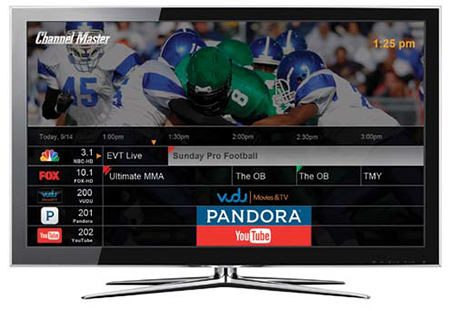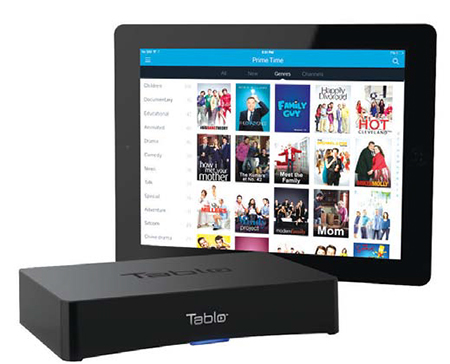OTA Antenna Systems Proliferate

Channel Master’s DVR+ integrates over-the-air and online content into a pay TV-style channel guide.
NEW YORK—Television viewers are starting to get back to their wireless roots.
As if traditional pay TV companies don’t have enough headaches from all the new over-the-top upstarts such as Sling TV and Sony’s PlayStation Vue—not to mention HBO Now’s recent debut on Apple TV devices— the nation’s cable, satellite and telco TV distributors have another new over-the-top threat to contend with: TV antennas.
Make no mistake: These offerings aren’t your grandfather’s rabbit ears. Companies with high-tech, futuristic names like Nuvyyo and Mohu are jumping into the game, along with TiVo, ChannelMaster, Tablet TV and Simple TV, all of which are combining state-of-the-art digital antennas with over-the-air digital video recorders.
New DVRs can snag content from over-the-air TV stations, the Internet and from subscription over-the-top services like Netflix, Hulu Plus and Amazon Prime Instant Video. Cobbled together, free broadcast TV and an online video-on-demand service offer a viable alternative to increasingly expensive pay TV packages.
Digital video recorder pioneer TiVo is probably the most well-known name to enter the space—it launched its OTA “Roamio” product last year and has since debuted a $49.99 version that allows customers to watch and record HD-quality broadcast stations, streaming video and subscription VOD.
In February, Roamio introduced a “One Pass” feature that allows viewers to track every episode of specific shows they want to catch up on and display them in a “My Shows” folder. Roamio also includes the intuitive TiVo guide and requires customers to pay a $14.99 monthly fee for storage and guide usage.
The professional video industry's #1 source for news, trends and product and tech information. Sign up below.
Other offerings from Mohu, Nuvyyo, ChannelMaster and Simple TV pair up desktop-size HD antennas that can draw in as many as 40 or 50 digital over-the-air channels in high-quality HD, with DVR capabilities and access to online video and over-the-top subscription services like Netflix, Hulu and Amazon Prime Instant Video, with hopes of extending it to HBO Now, Sling TV and Sony PlayStation Vue.
WHO’S THE AUDIENCE?
While choices continue to grow, the burning question for OTA companies will be just which demographic they are targeting, Telsey Advisory Group analyst Tom Eagan said.
“What is the demographic and psycho-graphic of those viewers: Are they willing to pay for a box and a monthly fee?” Eagan asked. “I think that the TiVo OTA device has potential, but the question is, how many of those 10 million [cord-nevers] will pay?”
For that reason, Eagan believes cable operators are safe for now.
“I don’t think it puts pressure on the MSOs because they don’t serve those viewers anyway,” Eagan said. “But it could serve to add marginal revenue to the programmers which they’ll need with the squeeze we expect due to operator consolidation.”
The idea is that cost-conscious viewers can significantly slash their pay TV bills by combining free over-the-air service with one or several OTT offerings. While the viewer won’t get all the channels they get on cable—and will still require a standalone broadband service for the online-video offerings—they can get most of the programming they want for a much-lower price.
For example, while a traditional expanded basic-cable package can cost about $75 per month for 150 channels, a consumer with an antenna (with a one-time equipment cost of $49.99 to $149.99) and a Sling TV subscription ($20 per month for around 20 channels and counting) will spend less than half that amount.
Over-the-air transmission is nothing new—it was TV’s original delivery method more than 70 years ago. But gone are the bulky and unattractive rooftop antennas and the unwieldy set-top rabbit ears that dominated the space for years. In their place are sleek, small and unobtrusive antennas that don’t look out of place on a bookshelf or mantle. And when coupled with an over-the-air digital video recorder and an online subscription video-on-demand service, they can offer an attractive alternative to traditional pay TV service.
There are about 12.6 million U.S. homes that watch only broadcast TV, according to Nielsen, versus about 100 million homes that have some type of pay TV subscription. And despite the free nature of OTA, getting access to subscription video-on-demand still requires a broadband connection. In most areas, that means maintaining a relationship with a cable or telco broadband provider.
Pay-TV operators have responded to the competitive threat with attractive bundle pricing: Comcast offers a package of 140 video channels and 25 Mbps Internet service for $79.99 per month for one year (rising to $121.90-$136.90 after the first year). The non-promotional price of standalone broadband can cost about $66.95 per month, making the bundle the better value.
But as consumers grow more frustrated and programming packages become more flexible, the pairing of over-the-air service with “skinny” video could become more compelling.
“In the same way that we’ve seen an enormous fragmentation of the channels people watch, “our view is that over the next 20 years, we’ll see a similar fragmentation in the platforms they use to watch these channels,” TiVo Chief Marketing Officer Ira Bahr said.
WEB COMPLEMENT
Free OTA television makes an ideal partner with emerging over-the-top subscription video services like Dish Network’s Sling TV (which brought ESPN outside of the traditional programming bundle), Sony PlayStation Vue and existing services like Netflix, Hulu and Amazon Prime Instant Video.
“You take an over-the-top service— whether it be either Apple or Sony or Sling TV or whatever, it really doesn’t matter— and you marry it with over-the-air signals; that’s going to be a powerful proposition for many consumers,” Bahr said.
The situation is a little different for TiVo, which has a large customer base for its more traditional DVR set-tops in the pay TV sector. Bahr doesn’t see TiVo’s Roamio box as a total replacement for pay TV, but as a way for consumers to access—and integrate— all of their services more easily.
But other companies focusing on the over-the-air space see two markets emerging— one for the 10 million or so households that have never had a pay TV subscription and a second for additional sets in pay TV homes.
According to Nielsen, the number of broadcast TV-only homes rose from 12.3 million in the fourth quarter of 2014 to 12.6 million in first-quarter 2015, while the number of TV sets has stayed relatively steady, at about three per household.
Increasingly, TV antennas are beginning to attract interest from cost-conscious customers and younger viewers who don’t want to pay for channels they don’t watch.
That could be a big selling point for OTA because, according to Nuvyyo CEO Grant Hall, broadcast is what most people are watching anyway.
“About 47 of the top 50 shows are available over the air,” Hall said. “There is still a lot of content that people rely on.”

Nuvyyo believes it can reach as much as 25 percent of U.S. households with devices such as the Tablo Metro. Nuvyyo just launched the latest version of its broadcast digital video recorder, the Tablo Metro, in the first quarter, and believes the market may be more like 20 million or 30 million homes, or between 20 percent and 25 percent of the nation’s 110 million television households.
Driving that increase, Hall argued, is the introduction of devices like Roku and Apple TV—estimated to be in about 20 percent of U.S. homes.
“I would argue that we’re kind of at the tipping point [where] OTT and OTA is really going to take off this year,” Hall said. “A lot of people are saying that this will be the year of the cord-cutter, 2015. All the tools are falling into place to replace the old legacy experience and I think there is demand out there.”
Unlike the not-too-distant past, when some antenna companies had to wait for the latest retransmission-consent blackout for a sales boost, consumers are increasingly warming up to the idea of free TV. Last year, Antennas Direct hosted an event in Washington, D.C., in conjunction with TVFreedom, a consortium of stations, small businesses and other groups interested in preserving over-the-air TV. It gave away 1,000 HD antennas is about an hour. Antennas Direct has said it has given away about 15,000 antennas over the past two years.
Others, like Mohu, have paired up with cable operators during blackouts for giveaways— CEO Mark Buff said the company has sold about 1.5 million to 2 million TV antennas since 2010 (it was initially a manufacturer of military antennas and has had pay TV-provider customers in the past). Though the momentum seems to be shifting toward a combination of over-the-top services and over-the-air stations targeting consumers who either never had a pay TV service or have recently cut the cord, Buff sees opportunity in providing a broadcast alternative for customers of more traditional pay TV providers.
“We certainly get phone calls from companies we wouldn’t expect to get phone calls from,” Buff said, adding that fights over retransmission consent have helped Mohu’s antenna business.
But not everyone is warming up to the idea that free TV will take a bite out of pay television subscriptions.
NOT QUITE ENOUGH
Pivotal Research Group principal and senior media and communications analyst Jeff Wlodarczak said he was skeptical that over-the-air television offers enough to get customers to cut the cord.
“Realistically, Netflix could drive consumers into these options better than anyone, but I doubt they would actually do so, given it would alienate the folks they buy content from,” Wlodarczak said. “So in the end I don’t think this makes pay TV nervous.”
Mohu has four antenna products: the Leaf Metro, the Leaf 30, the Leaf 50 and the Sky 60, ranging in price from $24.99 to $149.99 and delivering from 32 to 60 over-the-air channels. The devices are sleek, thin and compact—the Leaf 30 and Leaf 50 can fit on a bookshelf—and deliver high-quality HD signals that outperform pay TV in quality because signals are not compressed.
The over-the-air choices depend on the individual market but in metropolitan New York City, at least 58 digital OTA channels are available, including the digital feeds of the major broadcast networks, three public broadcast channels, Spanish-language broadcasters Telemundo and Univision and digital niche channels such as Antenna TV, Decades, Cozi TV and Bounce TV.
Earlier in March, Mohu launched Channels, a service that ties in SVOD providers like Netflix, Hulu and Amazon with its over-the-air offerings, which it hopes will resonate with customers. Mohu also is in talks with Dish Network to be a certified Sling TV partner.
“Up until Sling TV, your only option was Comcast and Time Warner Cable,” Hall said. “Now, that option is available if you have Netflix and Hulu, Sling and us—the local broadcast networks, two-thirds of all the shows that people watch—that combination gives you ammunition to say goodbye Comcast, goodbye Time Warner, goodbye Verizon.”
ChannelMaster executive vice president Joe Bingochea said OTA companies should strive to offer a growing menu of services. ChannelMaster, which has sold a line of antenna products since 1949 and has an over-the-air DVR product (DVR Plus), is readying its own OTA “linear” service to add to the mix.
The company launch the service, which basically allows it to aggregate and integrate over-the-top and online content, including The Pursuit Channel, the Outdoor Cooking Channel and Foodie TV, into its guide product at the NAB Show in Las Vegas.
“We want to give the consumer options,” Bingochea said. “If you want Sling TV, we want to have it on our box. If you want to order movies a la carte, we have Vudu for transactional VOD. If you want online video, we have YouTube for online.”
